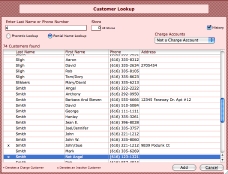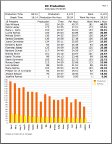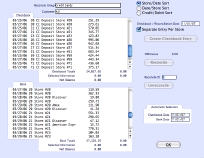Any good system will expedite the recording of business transactions
and provide meaningful reports. A really good system will transform
information into ways that were not possible, or practical, and will
provide the most accurate view possible.
Automated Data Processing (ADP) provides payroll services for
Sheldon Cleaners. Payroll and employee information is captured with
each payroll and transformed into the Human Resources system, albeit a
limited one. The only data entry at the office is setting up and
maintaining employee information in ADP. All time records are
electronic. Employee and department/store payroll, detail and totals
are captured, as well
as other employee information. Payroll and store sales are transformed
into the 'Labor Report'.
The Sheldon Cleaners 'Labor Report' goes back the late 1980's. Started
originally to help schedule counter clerks, the then 'Counter Labor
Report', compared
payroll with sales, to determine a labor percentage. How many people
you can afford to put in a store depends on sales volume. In recent
years,
the plant has been included as well, using separate totals for shirt
laundry and dry cleaning. Fine tuned over time, the current
version is a very accurate measure of performance, giving managers the
ability to schedule people effectively. The people have learned how to
interpret the results and make better decisions. In both store and
plant
operations, labor as a percentage of sales was significantly reduced
when the people paid attention to this report.
The boring task of bank reconciliation was a key transformation for
Sheldon Cleaners. Reconciling credit card deposits was a sloppy process
and identifying problems was difficult.
Many times it was the customer who identified the problem; not good for
business. I developed a Checkbook application that reconciles store
sales and
accounts payable information automatically with electronic bank records.
Checks and daily store deposits reconcile easily, matching check
numbers and deposit amounts. Credit card deposits reconcile in bunches,
as the bank recording of credit card deposits is much different than
ours. Groups of numbers are totaled until both sides match. There is a
manual reconciliation function that turns out to be a brain teaser game
of matching different number combinations. The automatic reconciliation
takes care of the majority of the volume of the transactions. What's
left is the small list of things that really do need attention.
An outside accounting firm provides financial services for Sheldon Cleaners.
All of the data above, coded with the proper account and other
financial information, is formatted to the specifications of their
software, and electronically captured by their system. Manual effort
is virtually eliminated. There are fewer questions. Money is saved
each and every month.
A critical transformation is the ability to rebuild a store computer as quickly as possible. A disk, with a
pre-configuration operating system, is cloned to a new computer. Once
connected to the office network, the point of sale server delivers
current store data. Now you're a store. The hardware allows this
to happen quickly, and the software assures data integrity. All at a time
when you need it most.
This next transformation can only truly be appreciated by me and
Roger Roelofs, the original developer of the point of sale system. The
good parts of the existing system were salvaged, and the bad parts were
thrown away. Perhaps the best part was the pricing engine, basically a
mini language Roger had written to deal with the pricing structure of a
dry cleaners. My time was spent on the user interface. It's now much
easier for new clerks to learn because of the visual clues and ease of
operation. Price list maintenance has a very advanced interface that
makes changes and updates easy. The price list is as complex as it is
important. The barrier to entry has been dramatically reduced because
of a better interface. I could afford to spend time here because of the
solid engine underneath me. Thanks to Roger.
Allow me to digress for a moment. The point of sale system is now at
version 3. Version 3's have always meant something to me. Microsoft
didn't get Windows right until version 3. Alright, 3.11. In version 1
of this system, the pricing routine only ran at the end of the order,
due to speed considerations. In version 2, it ran after each line was
updated, but was slow, and had issues. By version 3, the pricing
routine is more complicated, but quick. It runs all the time, without
thought. The hardware finally caught up to the business problem. The
quality of version 3 was significantly enhanced by the efforts of Bill
Heydenburg, now Office Manager, who diligently chased down bug, after
bug, after bug. And I fixed them all. I have never developed software
of this quality before. And Bill is an expert in all aspects of the
system.
The ultimate transformation is in the people. They have embraced
these new tools and achieved things not previously attainable. They
instinctively think differently about things. Yesterday's problems
don't exist because people are acting, not reacting. A few
people, like Bill, have transformed themselves into new positions
of
responsibility. A reward for the additional contribution they are
making to the company. And everybody
is happier.


